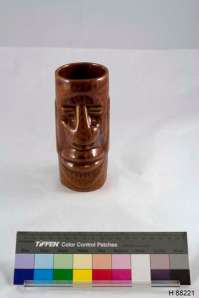New Collection Spotlight: Justice; Clothing Just for Girls
The Ohio History Connection is thrilled to have recently obtained a collection of over 60 items of Justice and Brothers clothing ranging from 2008 to 2017.
The Kahiki Supper Club was one of the best known restaurants in Columbus. Open from 1961 to 2000 , it was located on East Broad Street. Thirteen years after its closure, many still hold fond memories of the restaurant.

Glass from the Kahiki Supper Club from the collections of the Ohio Historical Society (catalog number H 88221).
After World War II, soldiers returned to the United States with stories and pictures from the South Pacific. This experience, in addition to a general increase in consumer spending, spurred Tiki culture, a romanticized mix of Polynesian and Pacific Rim food and tropical décor. The largest Tiki themed restaurant in the country would soon open its doors in Columbus.

Menu from the Kahiki Supper Club, a tiki themed restaurant formerly in Columbus, Ohio.
Originally it was a Tiki bar known as The Grass Shack, but a fire in 1959 led owners Bill Sapp and Lee Henry to conceive of building the largest Polynesian restaurant in the continental United States to be called the Kahiki Supper Club. The restaurant, designed by Columbus architect Coburn Morgan was built in 1960 at the reported cost of $1 million dollars. The building could hold over 500 guests, waterfalls, tanks of fish, live birds, large drums, and an iconic monkey fountain known as George; at the center of the building was a giant stone Moai fireplace. For most visitors though, the main draw was the variety of exotic drinks. The restaurant featured three bars and served drinks in over 30 different cups, goblets, and bowls. Visitors and celebrities came to the Kahiki from across the country; the first Columbus Asian Festival was planned in the basement of the Kahiki. In 1988, Michael Tsao bought out his partner and started a frozen food company next door to the restaurant. As Tiki culture went out of fashion by the 1970s, many Tiki bars and restaurants fell by the wayside. In 1997, the Kahiki was put on the National Registrar of Historic Places. Sadly, the Kahiki closed its doors in 2000 and was demolished afterwards; the giant stone Moai fireplace was removed by a giant crane before the building was demolished. The Kahiki brand continues to thrive today selling frozen Polynesian food in grocery stores across the country. There has been a renewed interest in Tiki culture across the country. Fans of the restaurant in Columbus can still visit George at the recently opened Grass Skirt Tiki Room.

Drink Menu from the Kahiki Supper Club formerly in Columbus, Ohio.

Tiki God Mask from the Kahiki Supper Club recently acquired by the Ohio Historical Society.
The Ohio Historical Society has some objects in its collection from the Kahiki including a dining and drink menu from 1999 exhibiting the food and drink the Kahiki was serving at the time of its closure, a Tiki god ceramic cup which once held one of the infamous cocktail drinks, and, our most recent acquisition, a wooden Tiki god mask that was once on the walls of the restaurant. While the restaurant is long gone, its legacy lives on in Ohio and across the country today.
Sources:
Kirsten, Sven A. The Book of Tiki: the Cult of Polynesian Pop in Fifties America. Koln: Taschen, 2000.
Rodgers, Rick, and Heather Maclean. The Mad, Mad, Mad, Mad Sixties Cookbook: More Than 100 Retro Recipes for the Modern Cook. New York: Running Press, 2012.
Whitaker, Jan. “Ohio + Tahiti = Kahiki.” Restauranting Through History. http://restaurant-ingthroughhistory.com/2013/05/28/ohio-tahiti-kahiki/ (accessed December 6, 2013).